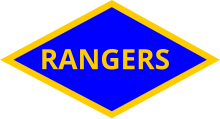| 4th Ranger Battalion | |
|---|---|
 WWII Ranger Battalions' shoulder sleeve insignia | |
| Active | 1943–1945 |
| Country | |
| Branch | |
| Type | Special operations forces |
| Role | Anti-tank warfare Artillery observer Close-quarters battle Direct action HUMINT Irregular warfare Long-range penetration Mountain warfare Patrolling Raiding Reconnaissance Special operations Special reconnaissance Tracking |
| Size | battalion |
| Engagements | World War II |
| Commanders | |
| Notable commanders | Roy Murray |
The 4th Ranger Battalion was a one of Ranger unit in the United States Army during World War II. Activated on 29 May 1943 in Tunisia, it was disbanded following the Battle of Cisterna in February 1944. Its lineage was integrated into the 75th Ranger Regiment in 1986 when it was consolidated with the Regiment's active battalions.
